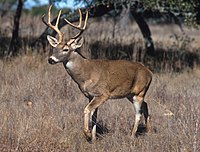
Photo from wikipedia
Background and Aims Global warming is shifting vine phenology, compressing harvests and altering the balance of fruit traits relevant to wine. Our aim was to test late pruning as a… Click to show full abstract
Background and Aims Global warming is shifting vine phenology, compressing harvests and altering the balance of fruit traits relevant to wine. Our aim was to test late pruning as a tool to delay maturity and to assess carry-over effects from repeated late pruning on phenology, yield components, dynamics of leaf area and berry traits of Shiraz grown in the Barossa Valley of Australia. Methods and Results A trial was established in a commercial vineyard comparing three pruning times during four consecutive seasons: (i) winter (Control), (ii) budburst and (iii) 2–3 leaves emerged. Compared with the Control, TSS in berries of vines pruned at 2–3 leaves reached 12°Be 7 days later in the first three seasons, and 14 days later in the last season; the budburst treatment was intermediate between that of winter and of 2–3 leaves. Yield was unchanged by late pruning in three seasons and increased in one. Leaf area index at harvest in 2–3 leaves was greater or similar than in the Control. Late pruning shifted the onset of anthocyanin accumulation against TSS, increasing the anthocyanin concentration and the anthocyanin-to-sugar ratio in two seasons. Conclusion Late pruning delayed maturity with neutral or positive effects for yield and berry traits. Carry-over effects on phenology, yield, leaf area and berry traits were negligible. Significance of the Study In a context of global warming, delaying pruning to 2–3 leaves can effectively spread the harvest and partially restore the anthocyanin : sugar ratio with no penalty for yield in Barossa Valley Shiraz.
Journal Title: Australian Journal of Grape and Wine Research
Year Published: 2017
Link to full text (if available)
Share on Social Media: Sign Up to like & get
recommendations!